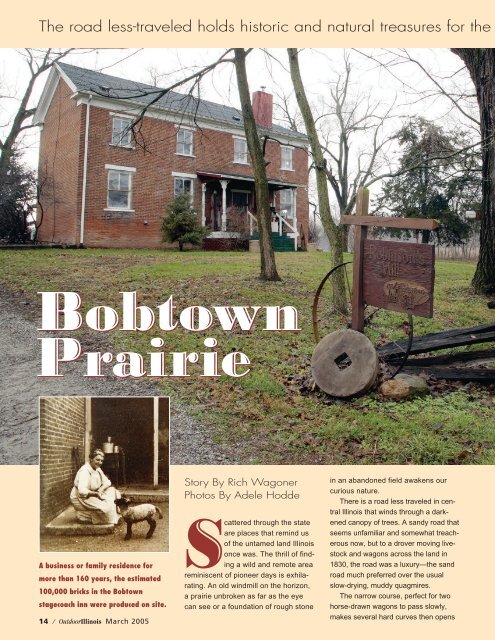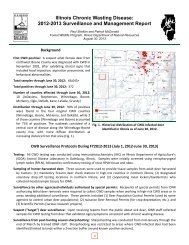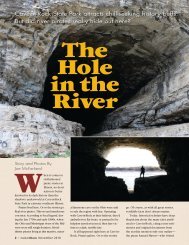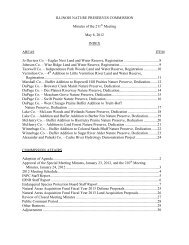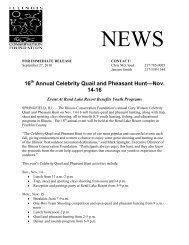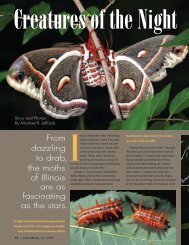OutdoorIllinois March 2005 Bobtown Prairie - Illinois DNR
OutdoorIllinois March 2005 Bobtown Prairie - Illinois DNR
OutdoorIllinois March 2005 Bobtown Prairie - Illinois DNR
You also want an ePaper? Increase the reach of your titles
YUMPU automatically turns print PDFs into web optimized ePapers that Google loves.
The road less-traveled holds historic and natural treasures for the<br />
<strong>Bobtown</strong><br />
<strong>Prairie</strong><br />
A business or family residence for<br />
more than 160 years, the estimated<br />
100,000 bricks in the <strong>Bobtown</strong><br />
stagecoach inn were produced on site.<br />
14 / <strong>Outdoor<strong>Illinois</strong></strong> <strong>March</strong> <strong>2005</strong><br />
Story By Rich Wagoner<br />
Photos By Adele Hodde<br />
Scattered through the state<br />
are places that remind us<br />
of the untamed land <strong>Illinois</strong><br />
once was. The thrill of finding<br />
a wild and remote area<br />
reminiscent of pioneer days is exhilarating.<br />
An old windmill on the horizon,<br />
a prairie unbroken as far as the eye<br />
can see or a foundation of rough stone<br />
in an abandoned field awakens our<br />
curious nature.<br />
There is a road less traveled in central<br />
<strong>Illinois</strong> that winds through a darkened<br />
canopy of trees. A sandy road that<br />
seems unfamiliar and somewhat treacherous<br />
now, but to a drover moving livestock<br />
and wagons across the land in<br />
1830, the road was a luxury—the sand<br />
road much preferred over the usual<br />
slow-drying, muddy quagmires.<br />
The narrow course, perfect for two<br />
horse-drawn wagons to pass slowly,<br />
makes several hard curves then opens
curious traveler.<br />
(Historic photographs from the collection of Tim and Char Wallace.)<br />
Traveling down muddy wilderness<br />
roads was difficult and often<br />
hazardous, and the appearance of<br />
the <strong>Bobtown</strong> stagecoach stop on the<br />
horizon was a welcoming site.<br />
torical Society is an 1840 map showing<br />
Robinson Mills—<strong>Bobtown</strong>’s original<br />
name—a few miles northwest of New<br />
Salem at the confluence of Clary and<br />
Little Grove creeks.<br />
This is the Clary Creek of Abraham<br />
Lincoln lore. Hanna Armstrong, mother<br />
of Duff Armstrong, the defendant in Lincoln’s<br />
most famous trial, was a neighbor<br />
and well known to James Robinson, the<br />
builder and proprietor of <strong>Bobtown</strong>’s<br />
combined stagecoach stop, post office<br />
and inn. Lincoln was assigned this area<br />
as a surveyor and traveled every inch of<br />
its rolling hills and flat prairies—including<br />
the road to <strong>Bobtown</strong>—searching for<br />
his direction in life.<br />
Clary Creek starts just west of New<br />
Salem and flows northward to the<br />
Sangamon River west of Oakford. The<br />
Welcome to Menard County and<br />
<strong>Bobtown</strong>, located a few miles from its<br />
sister city Lincoln’s New Salem, the latter<br />
memorialized today by the popular<br />
New Salem State Historic Site. Both<br />
cities’ fortunes rose and fell with the<br />
level of the Sangamon River, and these<br />
beautiful flowers of the prairie wilted with<br />
the coming of the railroad and modern<br />
transportation.<br />
The <strong>Bobtown</strong> stagecoach stop isn’t<br />
found on modern maps. Found deep<br />
within the records of the Petersburg Hisslightly<br />
to an old crossroad where stage<br />
coaches once announced their arrival<br />
with blaring trumpets. Years ago, a<br />
stage coach inn stood at the intersection,<br />
often surrounded by livery vehicles<br />
offloading freight—a chandelier from<br />
Paris or salt barrels from southern <strong>Illinois</strong>—and<br />
pioneers bravely venturing<br />
into the wild frontier.<br />
Modern-day explorers venturing<br />
down narrow, winding roads get<br />
glimpses into <strong>Illinois</strong>’ storied past.<br />
<strong>March</strong> <strong>2005</strong> <strong>Outdoor<strong>Illinois</strong></strong> / 15
Cool evenings were spent clustered<br />
around the fireplace, recounting<br />
experiences on the <strong>Illinois</strong> prairie and<br />
sharing dreams of the fortunes it held.<br />
land was an island of<br />
verdant splendor in the<br />
endless tall-grass<br />
horizons of early<br />
19th century <strong>Illinois</strong>.<br />
The beauti-<br />
<strong>Bobtown</strong><br />
<strong>Prairie</strong><br />
ful hardwoods<br />
now painting the<br />
bluffs above the Sangamon<br />
River were not<br />
here then. Yearly prairie<br />
fires burned the young trees<br />
and regenerated fresh<br />
growth. These hills were bald then—<br />
bald bluff prairies or hill prairies as they<br />
are now known.<br />
Nearby, evidence of the effort to<br />
restore some of the original bald bluff<br />
prairies can be seen, like the work at<br />
Witter’s <strong>Bobtown</strong> <strong>Prairie</strong>, preserved for<br />
the ages as an <strong>Illinois</strong> nature preserve.<br />
Years of undergrowth have been<br />
painstakingly removed to allow tall grasses<br />
and wildflowers to regain their<br />
foothold on the bluffs above the Sangamon<br />
River. Little bluestem, big bluestem,<br />
dropseed, sky blue aster, heath aster,<br />
showy goldenrod and pale purple coneflower<br />
are making a comeback.<br />
Grasses of the prairie were unbroken<br />
when <strong>Bobtown</strong> was built. Many considered<br />
it dangerous to live on the vast<br />
prairie—insects, fires and wild animals<br />
were seen as obstacles to early settlers.<br />
Wood and water were what the early<br />
pioneers needed and that is what Robinson<br />
found on Clary Creek—wood for log<br />
cabins and water to power his mill. People<br />
would come from 75 miles away to<br />
have the giant grist stones grind their<br />
meal and saw their logs.<br />
The mill became so popular that<br />
about 1843 Robinson built an inn to<br />
house travelers. Built in the then-popular<br />
Federal style, the private residence<br />
now is owned by Tim and Char Wallace,<br />
who estimate the building contains<br />
more than 100,000 bricks, all manufactured<br />
on site.<br />
Inside are many interesting antiques,<br />
collected to make the experience of living<br />
in a 160-year-old home more enjoyable.<br />
Original to the home are a journal<br />
from the early inn and grocery list from<br />
the 1850s. A worn, painted checkerboard<br />
tells of nights spent around one of<br />
the inn’s seven fireplaces, telling stories,<br />
enjoying a home-cooked meal and playing<br />
checkers.<br />
Next to the house stands a well—<br />
deep and dark with sweet, cool vapors<br />
rising from its depths. A tall, rugged-looking<br />
man might have once stood there,<br />
sharing a refreshing drink with other<br />
guests. A man who never forgot places<br />
like <strong>Bobtown</strong> when he left <strong>Illinois</strong> for<br />
greatness. One who would undoubtedly<br />
be happy knowing people still explore the<br />
less-traveled backroads of <strong>Illinois</strong>.<br />
Rich Wagoner is an avid outdoorsman,<br />
Wagoner enjoys backpacking<br />
and other outdoor sports. He resides<br />
at Ghost Hollow Ranch adjacent to<br />
Jim Edgar Panther Creek State Park<br />
near Chandlerville.<br />
Period antiques and a well-worn,<br />
painted checkerboard tell of<br />
days when the home welcomed<br />
visitors weary from their trek<br />
through the <strong>Illinois</strong> wilderness.<br />
16 / <strong>Outdoor<strong>Illinois</strong></strong> <strong>March</strong> <strong>2005</strong>


